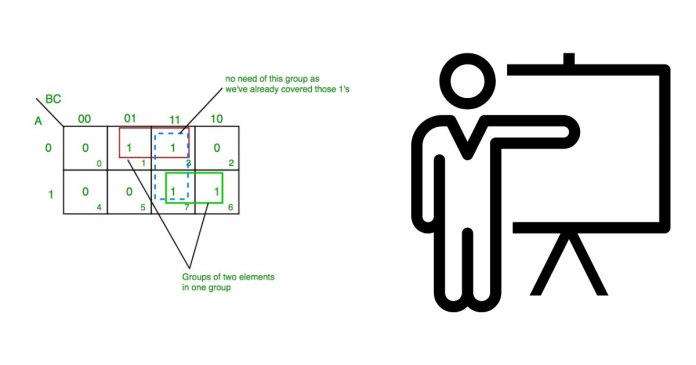A Karnaugh Map (K-map) is a graphical method used to simplify Boolean expressions. It provides a way to visually organize and minimize the complexity of logical expressions. K-map is especially useful for simplifying logic circuits in digital electronics, making it easier to design efficient circuits without needing extensive algebraic manipulation.
The K-map was introduced by Maurice Karnaugh in 1953 and is widely used in the design of digital systems. It is essentially a two-dimensional grid where each cell represents a possible combination of variable values, and the cells are filled with the corresponding outputs of a Boolean function.
Purpose of K-map:
The main goal of using a K-map is to simplify Boolean expressions by identifying patterns and common terms in a logical function. This results in a more efficient logic circuit with fewer gates and components, which translates to lower cost, reduced power consumption, and enhanced performance.
Basic Structure of K-map:
- Variables: K-map is used for Boolean functions with 2, 3, 4, or more variables. The number of variables determines the size of the K-map.
- For 2 variables: 2×2 grid (4 cells)
- For 3 variables: 2×4 grid (8 cells)
- For 4 variables: 4×4 grid (16 cells)
- For 5 variables: 4×8 grid (32 cells)
- Cells: Each cell in the K-map represents a possible combination of inputs (variable values) and contains either a ‘1’ or ‘0’ depending on the output of the Boolean function for that combination.
- Adjacent Grouping: The cells are grouped into adjacent rectangles (or groups), and the goal is to find the largest possible groups of 1s. Each group corresponds to a simplified term in the Boolean expression.
K-map for Two Variables (2 Variables):
For two variables, AA and BB, the K-map will have 4 cells corresponding to the possible combinations of AA and BB (00, 01, 10, 11).
| A\B | 0 | 1 |
|---|---|---|
| 0 | f(00) | f(01) |
| 1 | f(10) | f(11) |
- Each cell contains the value of the Boolean function for the corresponding input combination.
- The objective is to group the 1s in the map to minimize the Boolean expression.
K-map for Three Variables (3 Variables):
For three variables, AA, BB, and CC, the K-map will have 8 cells. It can be represented as:
| A\BC | 00 | 01 | 11 | 10 |
|---|---|---|---|---|
| 0 | f(000) | f(001) | f(011) | f(010) |
| 1 | f(100) | f(101) | f(111) | f(110) |
K-map for Four Variables (4 Variables):
For four variables, AA, BB, CC, and DD, the K-map will have 16 cells arranged in a 4×4 grid.
| AB\CD | 00 | 01 | 11 | 10 |
|---|---|---|---|---|
| 00 | f(0000) | f(0001) | f(0011) | f(0010) |
| 01 | f(0100) | f(0101) | f(0111) | f(0110) |
| 11 | f(1100) | f(1101) | f(1111) | f(1110) |
| 10 | f(1000) | f(1001) | f(1011) | f(1010) |
How to Simplify Boolean Expressions Using K-map:
- Write down the Boolean function: Start with a truth table or Boolean function.
- Fill the K-map: Place 1s and 0s in the K-map according to the truth table.
- Group the 1s: Look for groups of 1s in adjacent cells. Each group must contain 1, 2, 4, 8, etc., cells, and each group should be as large as possible.
- Write the simplified Boolean expression: Each group corresponds to a simplified term. The variables that remain constant in the group form a term in the simplified Boolean expression.
- If a variable does not change within the group (i.e., it is always 0 or always 1), it will appear in the simplified expression.
Example:
Given the Boolean function f(A,B,C)=∑(1,3,4,5)f(A, B, C) = \sum(1, 3, 4, 5), the K-map can be constructed as follows:
| A\BC | 00 | 01 | 11 | 10 |
|---|---|---|---|---|
| 0 | 0 | 1 | 1 | 0 |
| 1 | 1 | 1 | 0 | 0 |
Now, group the 1s:
- Group 1: The two 1s at cells (01) and (11) (corresponding to A=0,B=1,C= A=0, B=1, C= 00 and 01) can be combined.
- Group 2: The two 1s at cells (100) and (101) (corresponding to A=1,B= A=1, B= 00 and 01).
The simplified Boolean expression can be written by grouping the 1s and simplifying each group, resulting in the final simplified expression.
Advantages of Using K-map:
- Visual Approach: Provides a visual method for simplifying Boolean expressions, making it easier to understand and apply.
- Minimization: Helps in minimizing complex Boolean expressions, leading to simpler digital circuits.
- Efficient: Significantly reduces the number of logic gates required for implementing a digital circuit.
Limitations of K-map:
- Limited to a Small Number of Variables: K-map is effective for 2 to 4 variables. For larger Boolean functions (more than 5 variables), the map becomes cumbersome and difficult to manage.
- Manual Process: For larger expressions, the process of grouping and simplification can become error-prone.
Conclusion:
The Karnaugh Map (K-map) is a powerful and efficient tool for simplifying Boolean expressions in digital circuit design. It helps in reducing the complexity of logic circuits by minimizing the number of variables and operations involved. Despite its limitations for higher-variable functions, K-map remains one of the most commonly used methods for logic simplification in digital electronics.


